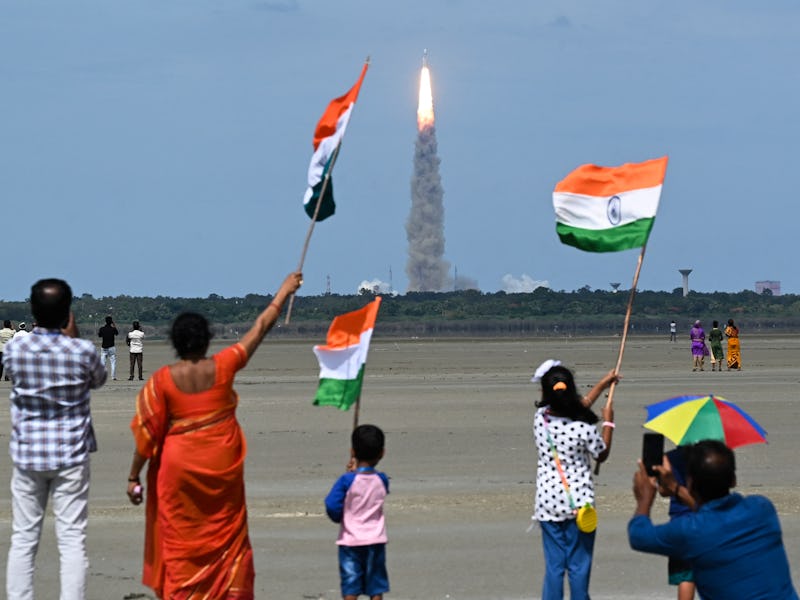India's New Moon Lander Successfully Touches Down at the Lunar South Pole
The landing makes India the first to reach the desirable real estate around the Moon's south pole.

India’s Chandrayaan-3 mission safely touched down near the south pole of the Moon early this morning. The landing — just days after Russia’s Luna-25 lander crashed while attempting to land in the same region — makes India the fourth country to land on the Moon. It also makes India the first to reach the area around the south pole, a part of the Moon that’s currently in multiple space agencies’ sights because of its stockpile of water ice.
Welcome to the Moon
After a six-week journey to the Moon, the Chandrayaan-3 mission’s Vikram lander parted ways with the Chandrayaan-3 orbiter and touched down on the lunar surface at about 8:34 a.m. Eastern on August 23. From its new home on the Moon, Vikram will spend the next two weeks measuring heat flow and seismic activity in the nearby lunar crust. A six-wheeled rover called Pragyan will roll out of the lander sometime in the coming day, to begin studying the mineral and chemical makeup of the local rock and regolith.
Chandrayaan-3’s successful touchdown comes just a few days after Russia’s Luna-25 lander crashed while attempting to reach the same region of the Moon, the area around the south pole. Although Luna-25 launched on August 10 and Chandrayaan-3 launched on July 14, the two spacecraft arrived at the Moon within days of each other (Chandrayaan-3 took a longer but more fuel-efficient route than Luna-25). Russia was poised to beat India to the landing by just two days – and then Roscosmos, the Russian space agency, lost contact with Luna-25 after a failed orbital maneuver, leaving the path clear for India to get there first.
The Indian Space Research Organization (ISRO, India’s space agency), despite operating with a fraction of NASA’s budget, has established itself as an up-and-coming major player in space exploration. Since the U.S. and China seem determined to frame the current flurry of Moonward activity as a space race, it’s fair to say that India just pulled ahead of Russia. So far the main action is still between the U.S. and China, but India could be poised to be a third contender.
People watch a live stream aired by Indian Space Research Organisation (ISRO) website at the Nehru Science Centre in Mumbai on August 23, 2023, minutes before the successful lunar landing of Chandrayaan-3 spacecraft on the south pole of the Moon.
All Eyes on the South Pole
The Chandrayaan-4 mission could launch sometime between 2026 and 2028 to analyze samples of rock and regolith, in the same way that NASA’s Curiosity rover picks up and studies rock samples on Mars. ISRO also plans to work with NASA to send Indian astronauts to the International Space Station in 2024.
India is now the fourth country ever to make a “soft landing” — as opposed to a crash, either accidental or on purpose — on the Moon, following the Soviet Union (but not post-Soviet Russia), the United States, and China. It’s also now the first country to land a spacecraft near either of the Moon’s poles. And that may be the more important distinction, since most of the major space players now have their sights set on the area around the Moon’s south pole.
Deep craters around the south pole appear to have water ice hidden in their permanently-shadowed depths, which could provide fuel, oxygen, and water for future lunar missions and the longer journey to Mars. On the other hand, the south polar terrain is extremely rugged, making it difficult to land on (assuming you want to use the lander afterward). So far, though, it’s not the terrain that has claimed so many of the spacecraft attempting to land here. Chandrayaan-2, whose lander crashed in 2019, fell prey to a software problem, and Luna-25 seems to have run into trouble with its engine.